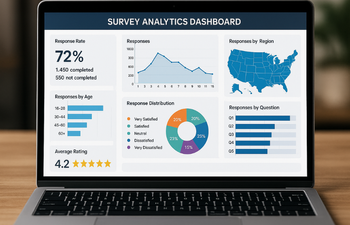Open-Ended vs. Closed-Ended Questions: Which to Use in Surveys?
Discover the pros and cons of open-ended vs. closed-ended questions to optimize your next survey strategy.

Introduction
Crafting the right questions can make or break your survey. One common dilemma researchers face is choosing between open-ended and closed-ended questions. Both formats serve unique purposes, and selecting the appropriate type can influence data quality, completion rates, and ultimately, the insights derived. Understanding when and how to use each is essential for creating effective surveys that gather reliable and actionable information.
What Are Open-Ended Questions?
Open-ended questions are prompts that allow respondents to answer in their own words. They don’t restrict answers with predefined options, giving participants freedom to express opinions, thoughts, and emotions.
Characteristics of Open-Ended Questions
- Invite narrative responses
- Capture unstructured, qualitative data
- Ideal for exploratory research
- Can uncover new themes or ideas
Examples of Open-Ended Questions
- What do you like most about our product?
- How can we improve your experience?
- Describe a recent challenge you faced at work.
What Are Closed-Ended Questions?
Closed-ended questions offer fixed answer options, making them easier to answer and analyze. They're commonly used when researchers seek quantitative data or standardized feedback.
Characteristics of Closed-Ended Questions
- Structured response format
- Easy to analyze and compare
- Great for statistical insights
- Suitable for large-scale surveys
Examples of Closed-Ended Questions
- How satisfied are you with our service? (Very satisfied, Satisfied, Neutral, Dissatisfied)
- Do you use our mobile app? (Yes/No)
- Which feature do you use most? (Feature A, Feature B, Feature C)
Comparing Open-Ended vs. Closed-Ended Questions
Each type of question has advantages and limitations. Let’s break them down side by side.
Advantages of Open-Ended Questions
Open-ended questions are powerful tools in understanding the “why” behind responses.
Rich Qualitative Insights
Respondents can provide detailed feedback that goes beyond the surface, offering stories and explanations that closed-ended questions might miss.
Flexibility for Unforeseen Answers
Because the respondent isn't limited, they might introduce ideas the survey creator hadn't considered.
Enhanced User Engagement
Allowing people to express themselves can increase their emotional investment in the survey, especially in customer satisfaction or employee feedback contexts.
Disadvantages of Open-Ended Questions
Despite their depth, open-ended questions come with trade-offs.
Time-Consuming Analysis
Responses need manual interpretation or sophisticated text analysis tools, making them resource-heavy.
Increased Cognitive Load
Participants may feel burdened by open-ended questions, leading to shorter responses or higher abandonment.
Inconsistency in Data
Lack of standardization can make comparing and aggregating responses more difficult.
Advantages of Closed-Ended Questions
Closed-ended questions shine in structured surveys with large audiences.
Ease of Analysis
With fixed options, responses can be quickly quantified and visualized.
Higher Completion Rates
Participants are more likely to complete surveys with mostly closed-ended questions due to their simplicity.
Scalability
Perfect for large datasets where uniformity is key.
Disadvantages of Closed-Ended Questions
Though efficient, closed-ended formats aren't without flaws.
Lack of Depth
They often miss nuances, emotions, and context that open responses provide.
Risk of Bias
Poorly designed options can lead respondents or fail to capture the full picture.
When to Use Open-Ended Questions
Open-ended questions are best used when exploring uncharted territory or seeking feedback on complex issues.
Ideal Scenarios
- Early-stage product development
- Customer feedback on recent changes
- Exit interviews
- Gathering testimonials
When to Use Closed-Ended Questions
Closed-ended formats are preferred when researchers know what they want to measure and need clear comparisons.
Ideal Scenarios
- Post-event satisfaction surveys
- Market research with large samples
- Behavioral tracking
- A/B testing feedback
Combining Open and Closed-Ended Questions
A hybrid approach often delivers the best results. Start with closed-ended questions to gather structured data, then follow up with open-ended ones to explore reasons behind responses.
For more on crafting effective survey questions, see our post on How to Write Survey Questions People Actually Want to Answer.
Impact on Response Rates
Survey design directly impacts participation. Overuse of open-ended questions can discourage users, while too many closed-ended items might lead to superficial data.
If you're concerned about survey fatigue, check out our article on Survey Fatigue Is Real.
Tools for Analyzing Open-Ended Responses
Text analysis tools like NVivo, Google Cloud Natural Language, or Excel with keyword clustering can simplify qualitative data review.
Bias Considerations
Closed-ended questions can lead to response bias if answer options are leading or incomplete. Ensure all relevant choices are included, and consider randomizing options when possible.
Ethical Survey Design
Ethical considerations should guide your use of both question types. Respect participant time, avoid manipulation, and ensure anonymity where needed.
Survey Length Optimization
Balance is key. Aim for brevity while capturing essential insights. Too many open-ended questions can create fatigue, while too few may lack depth.
Context Matters
Tailor your question types to your audience. For example, experts may prefer open-ended formats, while general consumers respond better to concise choices.
Cultural Sensitivity in Question Design
Always localize language and test cultural relevance. Open-ended questions, in particular, must be clear across diverse populations.
Accessibility Considerations
Design surveys with inclusive language and accessible formats to ensure all participants, regardless of ability, can contribute meaningfully.
Common Mistakes to Avoid
- Leading or biased questions
- Lack of answer variety in closed-ended questions
- Overloading surveys with too many open-ended prompts
- Ignoring follow-up insights
Conclusion
So, open-ended vs. closed-ended questions, what’s the final word? Neither is universally better. It all boils down to your survey's goals. If you're seeking numbers, trends, or quick answers, closed-ended is your go-to. If you're exploring new ideas or understanding emotional drivers, open-ended questions are your best bet. Better yet, combine them thoughtfully. Survey smartly, and your insights will speak volumes.
Frequently Asked Questions
Find answers to the most common questions about this topic
Open-ended questions allow for detailed responses in the respondent's own words, while closed-ended questions offer predefined answer options.
Use open-ended questions when you want detailed, qualitative insights or when exploring new ideas and perspectives.
Yes, closed-ended questions are ideal for quantitative analysis because they provide structured, easily comparable data.
Absolutely. Combining both can provide depth and breadth, quantitative data and qualitative insights.
They can, especially if overused or placed early in the survey, as they require more effort to answer.
Closed-ended questions usually lead to higher response rates because they are quicker and easier to complete.








